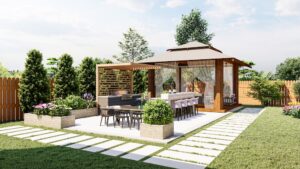 Adding an outdoor kitchen can elevate your backyard from a simple lounging space to a vibrant hub for cooking, entertaining, and relaxing. Whether you’re a grill master or a casual weekend host, an outdoor kitchen blends functionality with lifestyle appeal. But before firing up those built-in burners, it’s essential to understand the key planning, design, and maintenance elements that go into building the perfect alfresco culinary space.
Adding an outdoor kitchen can elevate your backyard from a simple lounging space to a vibrant hub for cooking, entertaining, and relaxing. Whether you’re a grill master or a casual weekend host, an outdoor kitchen blends functionality with lifestyle appeal. But before firing up those built-in burners, it’s essential to understand the key planning, design, and maintenance elements that go into building the perfect alfresco culinary space.
Why Add an Outdoor Kitchen?
An outdoor kitchen isn’t just a luxury—it’s an investment in your property and quality of life. It encourages more time outdoors, expands your usable living space, and boosts home value. In many climates, it can be used for three or even four seasons with the right planning and equipment.
Top benefits include:
- Enhanced entertaining: Cook and serve without having to shuttle back and forth inside.
- Increased home value: Outdoor kitchens often yield a high return on investment.
- Energy savings: Cooking outside reduces the need for indoor air conditioning.
- Lifestyle appeal: It creates a resort-like vibe right in your backyard.
Key Considerations Before You Build
1. Budgeting and Planning
Outdoor kitchens can range from $5,000 to over $50,000 depending on size, materials, and appliances. Begin with a realistic budget, and prioritize elements such as the grill, counter space, and storage. If needed, you can phase in features over time.
Pro Tip: Start with the essentials (grill, prep counter, sink), then upgrade with extras like pizza ovens, wine fridges, or warming drawers later.
2. Location and Layout
Choose a spot that complements your home’s flow. Ideally, it should be close enough to your indoor kitchen for convenience but positioned to reduce smoke drifting indoors. Wind patterns, sun exposure, and proximity to utilities (water, gas, and electricity) should all factor into placement.
Popular layouts include:
- Linear setups (great for narrow spaces)
- L-shaped kitchens (add prep room and seating)
- U-shaped islands (ideal for entertaining)
3. Materials and Durability
Everything outdoors needs to stand up to the elements. Choose materials that are weather-resistant, easy to clean, and safe around heat sources. Popular choices include:
- Countertops: Granite, concrete, or porcelain
- Cabinetry: Stainless steel or sealed stone
- Flooring: Slip-resistant tile, concrete, or composite decking
Ensure all materials are rated for outdoor use and suited to your climate.
4. Appliances and Features
The grill is typically the centerpiece, but today’s outdoor kitchens can include:
- Side burners
- Smokers or kamado grills
- Refrigerators and ice makers
- Sinks and dishwashers
- Storage drawers and trash pull-outs
Smart homeowners also incorporate lighting, ceiling fans, and built-in speakers to enhance ambiance and usability.
5. Safety and Permits
You may need permits, especially if you’re adding plumbing or electrical lines. Work with a licensed contractor familiar with local codes. Also, plan for proper ventilation and fire safety—especially if installing a roof or pergola.
Maintenance Tips
Outdoor kitchens are exposed to the elements year-round, so maintenance is crucial. Regularly clean grills and appliances, cover everything during harsh weather, and winterize plumbing if you live in colder regions. Investing in high-quality covers or even a partial roof structure can prolong the lifespan of your setup.
Final Thoughts
An outdoor kitchen brings together comfort, function, and curb appeal. With thoughtful planning and durable design, it becomes more than a cooking space—it’s a destination. Whether you’re hosting a summer BBQ or enjoying morning coffee with birdsong, this backyard addition can transform the way you live at home.
Compliments of Virtual Results






 Catch Our Feed
Catch Our Feed Subscribe via Email
Subscribe via Email Follow Our Tweets
Follow Our Tweets Friend Us On Facebook
Friend Us On Facebook Watch Us On Youtube
Watch Us On Youtube